 The wealth of images depicted in holy icons is overwhelming, yet one thing appears to unite them all. Despite not usually being painted in a naturalistic way, they are always concerned in depicting reality. In icons of the life of Christ, His Saints, or other historic events we are always presented with what happened, and the meaning behind what happened.
The wealth of images depicted in holy icons is overwhelming, yet one thing appears to unite them all. Despite not usually being painted in a naturalistic way, they are always concerned in depicting reality. In icons of the life of Christ, His Saints, or other historic events we are always presented with what happened, and the meaning behind what happened.
The image of St George killing the dragon, on the other hand, appears more like a fairy-story; indeed, it is a popular image in children’s story books.
So why are there literally thousands of holy icons surviving of St George killing a dragon, found in all parts of the Christian world, and spanning centuries?
George the Saint and Martyr
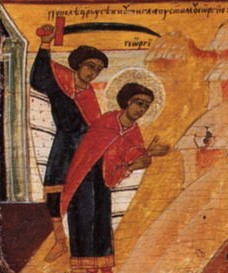
George the man was a Roman soldier born in the late 3rd century A.D. in Cappadocia, and brought up as a Christian by his widowed mother in her hometown of Lydda, in Palestine.
Under the emperor Diocletian a persecution of the Christians arose, and being a Roman commander by this time, George was ordered to take part. He refused and confessed his faith. Terrible tortures failed to weaken the young George (he was still in his twenties), but instead converted some of those who witnessed his confession, including Diocletian’s wife Empress Alexandria. Finally, George was beheaded. The year of his martyrdom was 303 A.D.
Keep exploring the icon of Holy Martyr George in the catalog >>
Just a generation later, when the Christian emperor Constantine ruled the Roman Empire, there was a church dedicated to St George and his relics were kept at Lydda for veneration by local Christians.
With such an early and widespread devotion to St George, his image became, and remains, consistent, being based on his actual physical appearance in the world. He is shown as a youth (beardless), with rows of curly brown hair. He is dressed as a soldier, and relating to that images of him riding a white horse also date back to the first millennium. Sometimes he is also shown wearing a jeweled diadem on his head, a Near-Eastern version of a royal crown, relating to his “crown of martyrdom”.
The Miracle of St George and the Dragon
St George has come to be known as the Great-martyr, Victory-bearer and Wonder worker George. This is testimony to not only his life and death (earning him the title of Great Martyr) but also the miracles God worked through him after his martyrdom. The history of the Church is full of posthumous appearances of Christ’s Saints, who not only appear as messengers, but also to protect and work miracles for Christians struggling on earth. The rescue of a princess and town from the ravaging of a reptilian beast is one miracle attributed to St George.
Various versions exist, but the most widespread concerns a town called Silene, near a lake in Libya. In the lake lived a creature variously described as a dragon, a giant serpent, or even just a crocodile. The beast prevented the inhabitants of Silene from drawing water easily from the lake and generally terrorized the town. Being pagan, the superstitious townspeople were under the misapprehension that offering young virgins, chosen by lot, as sacrifice to the monster would keep the town safe. Inevitably, the lot fell to the king’s daughter (identified as Elizabeth in a few Russian icons), and despite the pleas of the ruler, his daughter was sent to the lake.
The old dragon emerged from the pool, ready to eat the princess, when suddenly St George appeared on a radiant white horse, armed with spear, shield, and sword. Making the sign of the Cross, and in the name of “the Father, the Son, and the Holy Spirit”, St George transfixed the dragon to the ground with his spear, whilst his horse trampled the serpent under its hooves. St George commanded the princess to bind the neck of the dragon with her belt and lead the beast back to the town. Once there, in front of the astonished citizens and the grateful king, St George dispatches the dragon with his sword.
The miraculous intervention of George led to the conversion of the whole town to the Christian faith.
Some details of the story vary in the retelling, indicating news of the event was initially transmitted orally (the earliest written accounts date to the 11th and 12th centuries). However, the main parts of the story: the princess, the dragon bound with a belt, the pagans hiding behind their town’s walls, and of course St George himself, appear in a wide range of frescoes and icons, dating back to the 12th century. This stone coffin carving from Conisbrough, England, has a carving of George fighting the dragon (the lower picture) and dates from the 11th century.
The Dragon: Miracle, Myth or Symbol?
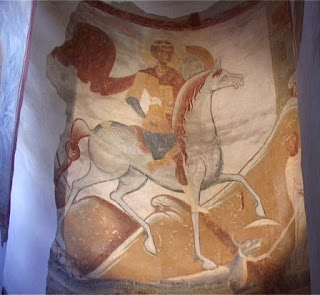
Whilst it is beyond doubt that George the soldier and martyr existed, the contemporary Christian mind tends to struggle with him killing a dragon and rescuing a princess. It reads too much like a fairy-tale and so the temptation is to label it as that, and concentrate on the symbolic meaning of the story.
The Symbolism of the Story and its Icons
There is indeed strong symbolism behind the story and icons of St George slaying the dragon. The dragon and the serpent are both descriptions given to the devil by St John in his Revelation (Rev 12:9). Whatever the true nature of the beast, it is described as a dragon in the earliest written records, and depicted as a serpentine dragon in the oldest surviving images, to deliberately evoke this imagery of the devil.
St George’s appearance also deliberately evokes Biblical symbolism. Again in the Divine Revelation to St John, the Apostle writes:
And I saw, and behold a white horse: and he that sat on him had a bow; and a crown was given unto him: and he went forth conquering, and to conquer (Rev 6:2).
Take a look at the hand-painted icon of St George the Victory-Bearer >>
A conquering soldier upon a bright white horse is precisely how St George is described in both the written and painted accounts of the miracle. Icons of the miracle also often show a crown being brought down from heaven and placed on George’s head by an angel. Other icons, especially from Greece, will also show George with a bow and quiver of arrows near his saddle, completing the comparison with the horseman in Revelation.
This is the image and icon the miracle of St George presents us with: the Martyr who has become a conquering hero. St George sits atop his conquering white steed, red cloak of martyrdom billowing behind him, with the blessing of Jesus Christ indicated by the hand reaching forth to bless him. He rides forth conquering: the devil first of all, in the form of the dragon, and then latterly the inhabitants cowering behind the town walls. Ensconced in their fortress, they look fearfully on because they too are conquered by St George: not through force, but by their conversion to Christianity after seeing the wonders performed by God through him.
The Novgorod-style depictions of St George
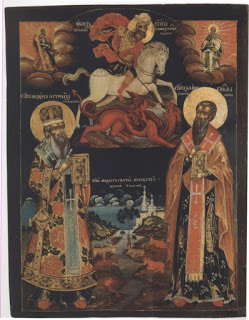
The iconographers of Northern Russia were wont to paint in a stripped-down minimalistic way, removing all but the main details of the scene depicted. A perfect example of this is the icon of The Hospitality of Abraham painted by Andrei Rublev, which removes everything from the scene except the Three Angels and the table they sat at, producing an image of the Holy Trinity.
St George is another example, as in Northern icons painted of him during the 15th centuries, the princess, the town, and even the lake are all removed:
All is left is the Martyr George on horseback, receiving the blessing of Christ from above. He is alone in the desert with the serpent-like dragon, which appears to come from a pit rather than a lake, fighting with the beast. As in the story George is victorious, and the dragon is pierced through the mouth, yet the image here becomes more like a general picture of the Saints’ victory over the passions, fought in the solitude of the inner heart (the desert wilderness of the icon).
Taking the Symbolism too far
Clearly the story and image of St George killing the dragon has been understood symbolically from the beginning, reaching its iconographic climax in the 15th and 16th centuries. Therefore it is not, either “modern and enlightened” on the one hand, nor “hyper-rational and critical” on the other to give this symbolic meaning to icons of St George killing the dragon: the medieval Christians before us understood it too.

Nevertheless, there is a temptation to totally disregard the account of the original miracle, as though the symbol of George killing the dragon came first, and that the princess and the Libyan pagans were invented later as a story to flesh out the symbolic image. This cannot be the case, as some of the earliest images of St George killing the dragon (11th and 12th centuries) also include other details, like the princess leading the dragon with her belt: details which aren’t as easy to interpret symbolically. A good example of early images of the “complete” miracle is the fresco from St George’s church in Staraya Ladoga, North Russia, which dates from the 1160s.
Perhaps the dragon was a description given to a creature far more recognizable to us living today, though the other aspects of the story: the pagans sacrificing their townspeople to this beast, the deliverance by St George, and the pagans’ subsequent conversion must be taken at face-value. Far greater miracles have been worked in God’s name, and if we are willing to look a bit gullible or foolish to the world for believing the Resurrection and Acts of the Apostles literally happened, then it’s no worry to do the same for this miracle.
More important, though, is to understand the meaning of the miracle. It is more than likely that the historical miracle and the symbolic interpretation of the miracle happened at the same time. This is how it happened in the Scriptures too: a miracle was not done for the sake of doing a miracle, but “for the glory of God, that the Son of God might be glorified thereby.” (John 11:4, and at other places in John’s Gospel especially).

The rider on the white horse in Revelation is a figure given to the first-century Christians as a sign of hope, and that by staying faithful they will be victorious amidst persecutions. The image of St George transfixing the dragon was given to Christians in later times, when they too were in need of hope. Though the Byzantine Roman Empire was Christian by the end of the first millennium, her lands were beset on all sides by non-Christians of various types: pagans, Muslims, and even Christian heretics like the Arians. St George appeared to the besieged Christians as the conquering hero to strengthen their confession.
St George as the “Victory-Bearer” and “Dragon-Slayer”continues to be a persistent image today for Christians, whether struggling with external or internal attack. The reason is two-fold. Firstly, the image of George and the Dragon is striking, and no doubt many iconographers enjoy painting the Saint in such an unusual pose; yet that wouldn’t be reason enough if the miracle of St George were a myth. Therefore the second and most important reason why the image persists is because God continues to work miracles through St George’s intercession even today for those faithful Christians who turn to him for help.
God raised you as his own gardener, O George, for you have gathered for yourself the sheaves of virtue. Having sown in tears, you now reap with joy;
you shed your blood in combat and won Christ as your crown. Through your intercessions, forgiveness of sins is granted to all.


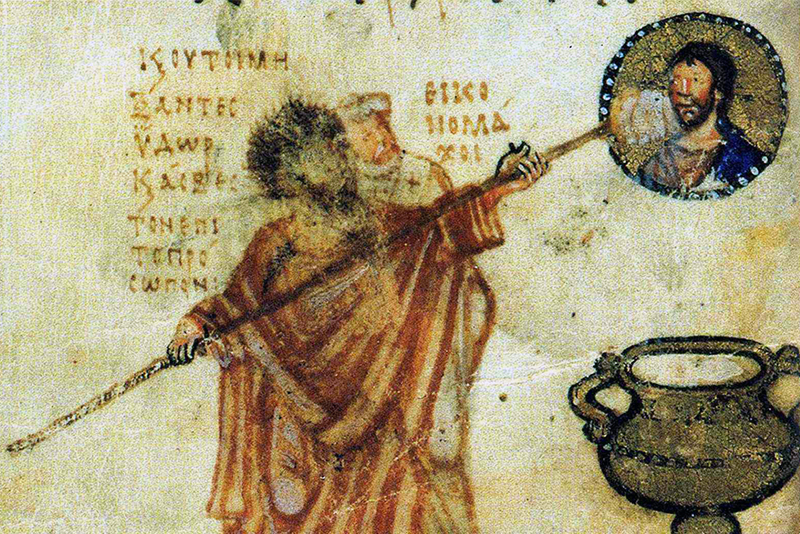
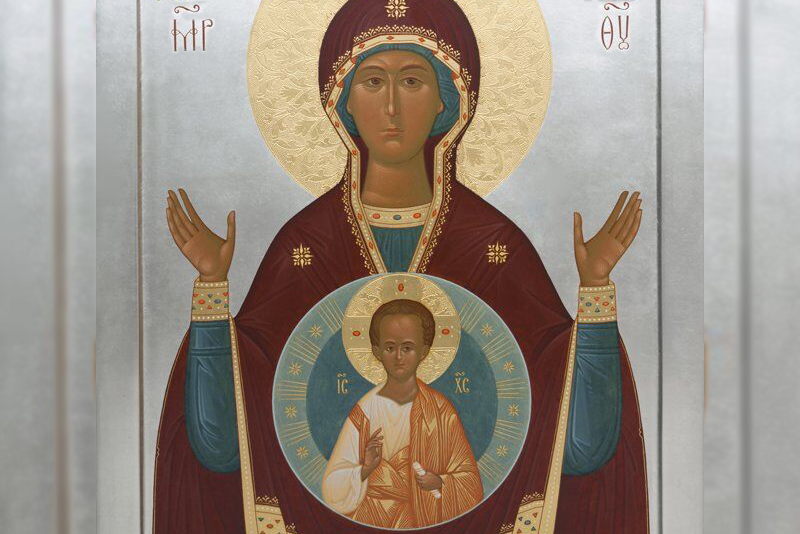
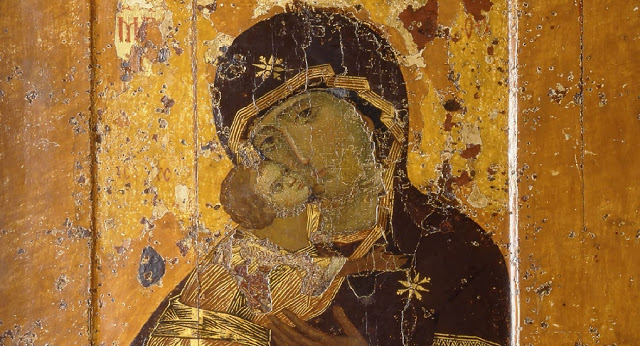
Beautiful article on St. George and the dragon.